Random email blasts have become a ‘thing of the past’!
Gone are the days when a single email message was enough for all the subscribers. Current times are bringing in customization like never before. The moment your subscribers will feel that your emails aren’t bringing any unique value proposition to the table, they will start losing interest or worst still, will mark your emails as spam. The benchmark email marketing success theory relies upon personalization; and email list segmentation is its linchpin!

Generalizing your audiences can cost you, thus, email segmentation tops the list of email marketing best practices.
Email Segmentation is a process of splitting up your subscribers into smaller groups based on different criteria. The key purpose behind email segmentation is to provide impactful personalization. Relevancy is a crucial element for any email marketing campaign, and segmentation helps to deliver the desired message that triggers action.
When it comes to eCommerce email marketing, the subscribers are large in numbers as well as diverse. Mailchimp reports an average email open rate for the eCommerce industry to be 15.68%, wherein segmented email campaigns earn 100.95% higher click-through rates than non-segmented ones. Email list segmentation in eCommerce is vital for its divergent buyer personas and behavioral aspects.
Here, we have listed down 10 advanced email segmentation tactics that will help you out in designing hyper-targeted email marketing campaigns for your eCommerce business. Let’s start…
1. Segmentation Based on Sign-up Source
The basic eCommerce email segmentation tactic is to define and differentiate a few preferential details of your subscribers at the time of sign-up. When a website visitor shows interest in subscribing to your email newsletter, you can ask a few baseline questions like their shopping preference for receiving updates regarding male, female, kids, or for all the products. This way, you can determine the sort of email campaign you want to design around them.
Another example of sign-up source segmentation is to identify the frequency of emails your subscribers want to receive on a weekly or monthly basis. When you fulfill this criterion by maintaining opted email frequency, chances of unsubscribes or spam reports decrease. Check out the example by SSENSE in which they’ve utilized the newsletter sign-up form.
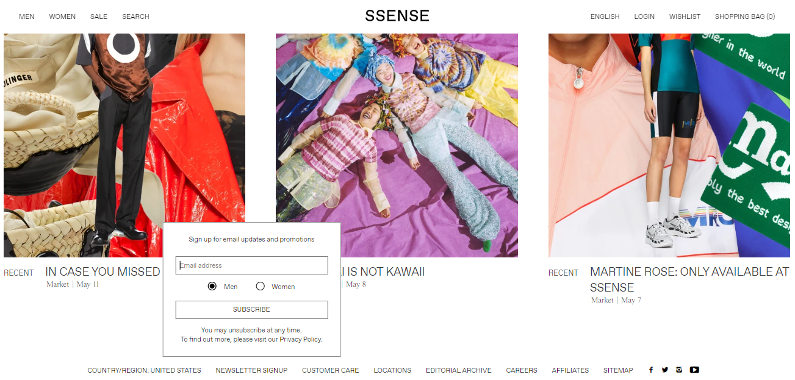
2. Segmentation Based on Demographics
A baseline demographic segmentation can be achieved from the sign-up source itself. But, if your business demands to gather more in-depth details about your subscribers, you need to ask them separately once they come on board.
Demographic segmentation goes beyond just the gender or email frequency. For better-targeted email marketing, brands learn more and more about their users’ age, interests, income level, profession, and more. The tricky part is how well you ask these questions by keeping their trust intact and know when to stop! Demographic email segmentation helps in sending highly personalized emails that are relevant and add value to the groups. Depending upon the kind of business, gather the demographic information to optimize your email campaign performance.
In an email by eBay, to segment their list, they’re collecting data by asking their subscribers about whether they are interested in buying or selling and if eBay can help in other ways possible. Check it out!
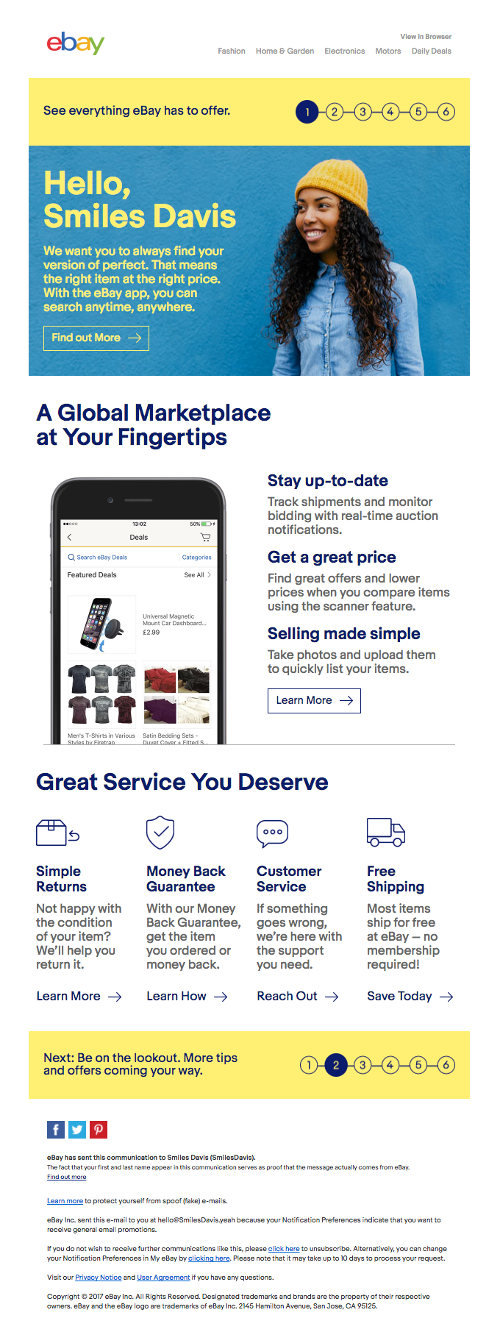
source: Really Good Emails
3. Geography Based Segmentation
eCommerce is all about knowing your consumer better to offer them with suitable requirements! Geographic or location-based email segmentation plays a vital role when your products are influenced by geographical aspects.
Segmenting location-based groups is highly recommended when you are organizing in-store events or ship to only a particular geography. For instance, sending a shopping invitation email taking place in Chicago to a person residing in Germany will not make any difference to the subscriber. On the other hand, knowing your subscribers’ geographical data will help you craft email campaigns based on their location and seasonal changes.
Check out the below example from COMPASS, it provides location-based property services. The email comprises listing, agent, and neighborhood information.
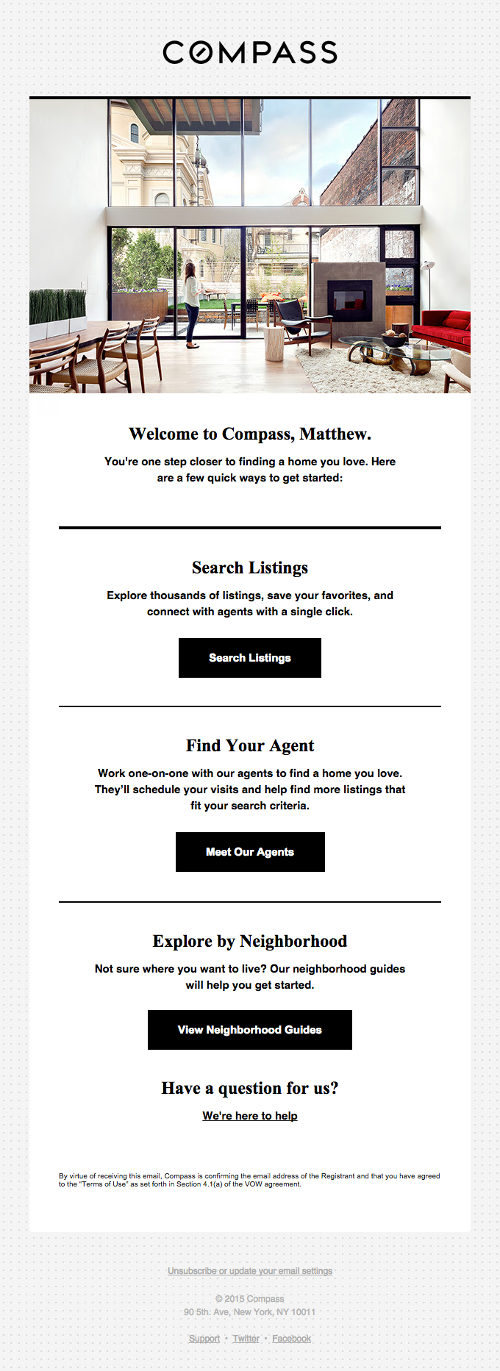
4. Segmentation Based on Website Engagement
Studying how people engage on your website can help you collect a lot of useful data. Behavioral data helps in effective-personalization, and that’s the most lucrative way to market! Sending personalized emails based on visitors’ website activity can boost up to 6x higher revenue and transaction rates. By analyzing website activities, you can get segmentation details for:
- The pages visited
- The bounce rate
- The amount of time spent on each page
- The response towards CTAs and other webpage elements they click on
- The type of products they’re interested in
Service providers like Mailchimp facilitate their users with ‘goal’ oriented email segmentation based on the website content people engage with.
MACY’S sends an email with ‘like what you saw’ message to the website visitors to lure them for what they’ve recently browsed.
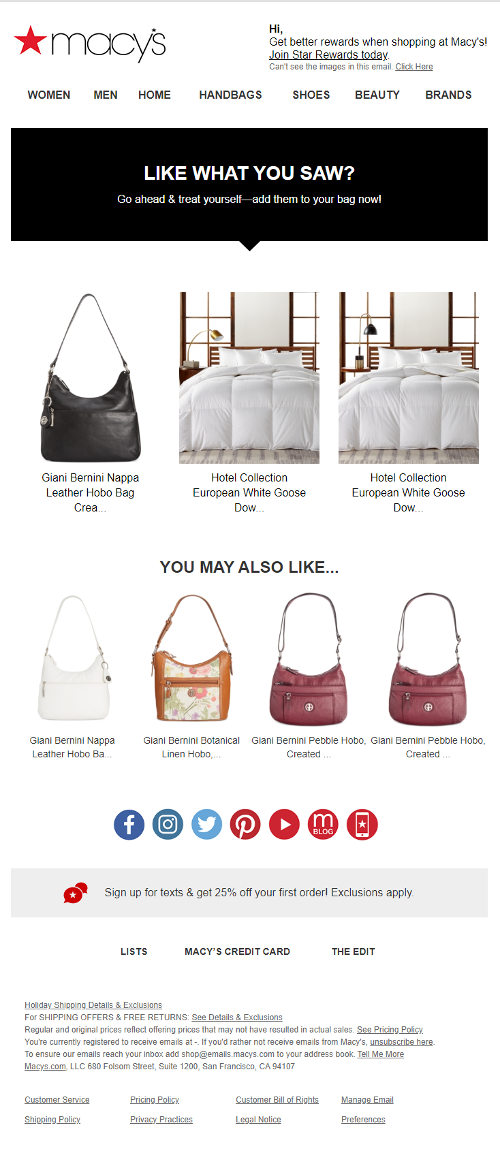
source: Milled
5. Segmentation Based on Email Engagement
Email engagement metrics play a major role when it comes to segmentation. For the result-oriented email campaign, it is essential to keep a keen eye on the engagement metrics and make changes as and when necessary.
As an eCommerce brand, your subscribers are your leads, and sending them relevant emails is a part of the nurturing process in your sales funnel. The catch in segmenting email lists based on your engagement metrics is to differentiate quality leads from the regular ones. If you are sending the same, generalized emails to all your subscribers, there are higher chances of your efforts getting wasted.
Identifying your audiences based on engagement and then segmenting them accordingly is vital! Measure your email open rates, click-through rates, conversion rates, as well as unsubscribe rate to better target the ones who are more likely to buy from you.
6. Segmentation Based on Buying Frequency
Another imperative email segmentation tactic is to group your customers based on their buying frequency. It is important to identify the ones who are reading your content and responding to it, but it is brutally crucial to segment the regular customers. Every consumer is essential, but the ones who are always giving you revenue should be kept, nurtured, and treated differently. Define the frequent and infrequent buyers to send them emails that trigger shopping. Sometimes with a customized HTML email template saying ‘thank you’ and sometimes with a discount code.
Here’s an example by CHEWY. Considering past orders from the consumers, it sends ‘reorder’ emails with top, relevant product-picks.

Source: Really Good Emails
7. Segmentation Based on Top Order Value
People who are already buying from you need to be segregated upon their buying behavior than just the pattern. There might be Mr. X who’d buy every month of the year for gross revenue of $500, wherein, Mr. A would buy twice a year with some super purchases of $1000 each. Segment your customers with the top order value distribution to never miss out on an opportunity to sell better. Mr. X and Mr. A both are loyal, but targeting them with the same email campaigns will not yield desired outcomes.
8. Segmentation Based on Cart Abandonment
Cart Abandonments are the dignified revenue losses! Studies have derived that an average cart abandonment rate across all industries comes out to be nearly 70%. It is extremely important to segment cart abandonments and send ultra-targeted emails to such visitors. Custom email templates with a personalized message about the users’ abandoned items can win back many who might otherwise not buy.
Check out the following email template with some up-sell and cross-sell features by Uncommon Goods for their cart abandonment campaign.

[contact-form][contact-field label=”Name” type=”name” required=”true” /][contact-field label=”Email” type=”email” required=”true” /][contact-field label=”Website” type=”url” /][contact-field label=”Message” type=”textarea” /][/contact-form]
9. Segmentation Based on Subscriber Inactivity
Cleaning your subscribers’ list is yet another aspect that affects the overall campaign performance. Scrutinizing subscribers based on their periodic inactivity will improve your engagements. You can separate such subscribers and target them with a different agenda to gain opens or trigger any sort of engagement.
These are called ‘win back’ emails where at the end of the follow-up cycle, you should let go of those subscribers for better email campaign performance.
10. Segmentation Based on Loyalty Index
Last but a critical one is to segment your customers or subscribers based on their brand loyalty. These customers are your assets and you can bank upon them! The purpose behind segmenting based on the loyalty index is to utilize them for referrals or more importantly up-sell. Loyalty bonus, reward programs, special discounts, referral offers, reviews, and more are the kinds of campaigns that you run for these customers.
Check out Target’s review email below!
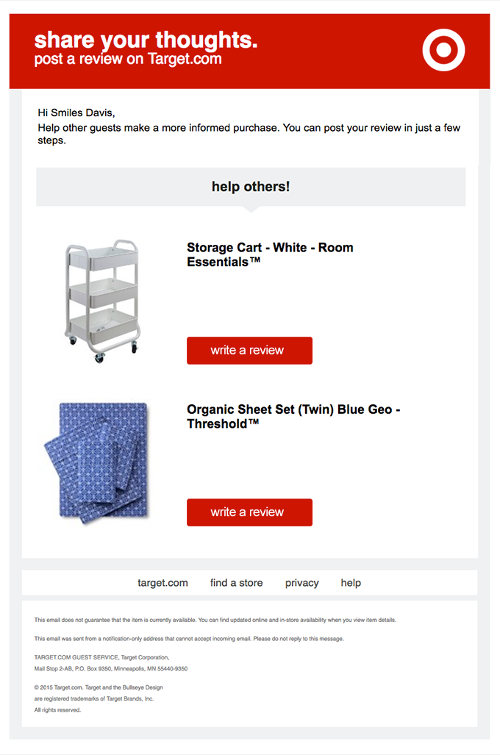
Wrap Up
Segmentation is the true blue practice to follow! eCommerce businesses are banking upon their online presence when it comes to sales and leveraging email marketing is the smartest way to go about it. Follow the mentioned tactics to segment your subscribers, and design html email templates and campaigns around them just to witness a performance boost.


